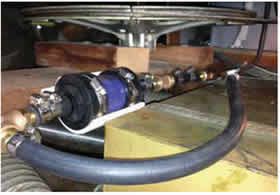
The Coast Guard and the American Boat and Yacht Council (ABYC) have worked together to develop general installation guidelines for the carbon canisters required under the EPA’s evaporative emission regulations. While the standards (AYBC H-24) don’t specifically apply to the H2Out AVD unit when installed in diesel fuel systems, they represent good basic commonsense and should be followed with any fuel tank vent adsorbent product. We have added a few tips and precautions learned during our testing.
- An air/fuel separator or other mechanism must be placed between the fuel tank and the adsorbent housing to prevent spit-back from reaching the carbon canister during fueling.
- The canister must be supported, and the hoses must be supported within 6 inches of the fittings on each end. Secure all hoses and protect from chafe.
- The canister should be installed at a high point in the system. Self-draining lines are recommended. Special valves make other locations possible, but this has been a problem in automotive installations, and Practical Sailor can’t recommend it. Low mounting locations are common in powerboats.
- The filter should be installed such that any adsorbent media that migrates out of the housing will fall out the through-hull, not into the anti spit-back valve or tank. This is a common cause of trouble with automotive canisters.
- The operating temperature should not exceed 115 degrees, except for limited exposures to 125 degrees. Heat shielding is acceptable and is required in engine-room installations.
- The canister must be accessible for maintenance. However, like the unit in your automobile, they should function unattended for very long periods.
- A secondary pressure-relief mechanism is recommended, particularly for low-point installations. Attwood sells a fill cap with built-in pressure relief. A bypass-line with a poppet check valve will also work. We would rather see good installation at a system high point-additional pressure-relief complications would not be needed-but manufacturers can’t rely on good installation practices, and many small powerboats lack the space, and thus must use more complex automotive-style solutions.
- Because they do not contain liquid fuel, the filters are exempt from the Coast Guard burn-test requirement, unless located in the engine compartment. However, we still recommend using Coast Guard-certified fuel-grade hose.
- Leak-free design and installation is essential, particularly on gasoline fueled boats. Although, the canisters should never contain liquid fuel, they could, and they certainly contain vapors.
- Watch for any puff of air from the fill opening when the cap is removed; this is a sign of vent restriction. All gasoline tanks and many diesel tanks have screens or other flame arrestors installed, most often in the through-hull. Although a puff is common on the sealed fuel systems in cars, pre-2012 boats have freely vented systems and should never build observable pressure. This is true with or without a vent filter. We have not observed any pressure build-up on our test boats.




































